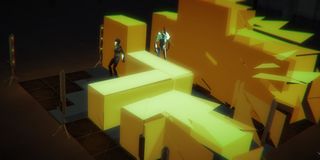Volume: duping guards in a tense, tactical sneak-'em-up

Some critics have compared Mike Bithell’s new stealth game Volume to the VR missions in the original Metal Gear Solid. Once I noticed the most basic similarity in colour scheme and visual style, I found it a hard comparison to shake. That expansion broke down Metal Gear’s stealth down into its core components, with levels that functioned as stealthy self-contained time attack challenges. Volume is like a whole game of that, offering similarly inventive ways to manipulate enemies and reach level exits.
Unlike Snake, your character, Locksley, can’t kill anyone, and as the name Volume suggests, manipulation of sound is his weapon. Just like the original MGS, before it transitioned its more experimental first-person crotch-shooting sequels, this is stealth in absolutes. The patrolling enemies have vision cones that are 1:1—if you wander into their sights, there’s no ambiguity about whether a guard saw you or not. The objective in each level is to collect items dotted around the map and then reach the exit point. If a guard successfully pursues you for a few seconds, it’s game over. If you manage to escape, the guard will hit the alarm and others around the level will start searching for you. There are variations from the regular guards, too. There’s a sniper whose vision cone stretches into long-range and another who can see in 360 degrees, which makes sneaking past in the conventional way is pretty much impossible.

That’s where Locksley’s tools come in. There’s the bugle, which is a projectile-based noisemaker which lets you aim, shoot and lure an enemy from their post before sneaking past. There’s the veil, which Bithell describes as the Hitman button: pretend to be someone else for a very short space of time so you can sneak by an enemy quickly. There’s also a decoy move where you can send a clone of yourself running through a guard’s line of sight and get them to chase. Then there’s my personal favourite, the oddity, which you can stick to any surface to draw the fascinated attention of any guards in range; Metal Gear’s equivalent of this is basically filthy magazines, the bane of any private military force. These ensure each level has a number of solutions, and because you can only carry one at a time, a bit of experimentation might be required to crack it. There’s a basic whistle move to draw enemies out, too, and sticking to cover keeps you safe from any patrolling goons.
It amounts to an enjoyably precise stealth game that’s simple to learn. Using the bugle to make an enemy move just inches off the spot, then quickly zipping around them and progressing to the next few gems is satisfying, and the frequent in-level checkpointing means it doesn’t feel frustrating, either. I think I only yelled the f-word once during my demo, which bodes well considering I’ve thrown and broken expensive peripherals after being caught in stealth games past.
Whether it’s complex enough to stand up over the targeted 100 levels depends on how well the difficulty scales. Volume feels ideal to play for maybe 20 minutes at a time, and the addition of a level editor identical to that used by the level designers lays the groundwork for potential longevity, too. Mike Bithell’s follow-up to Thomas Was Alone will be released in Spring on PC, shortly after its PS4 release.
The biggest gaming news, reviews and hardware deals
Keep up to date with the most important stories and the best deals, as picked by the PC Gamer team.
Most Popular

